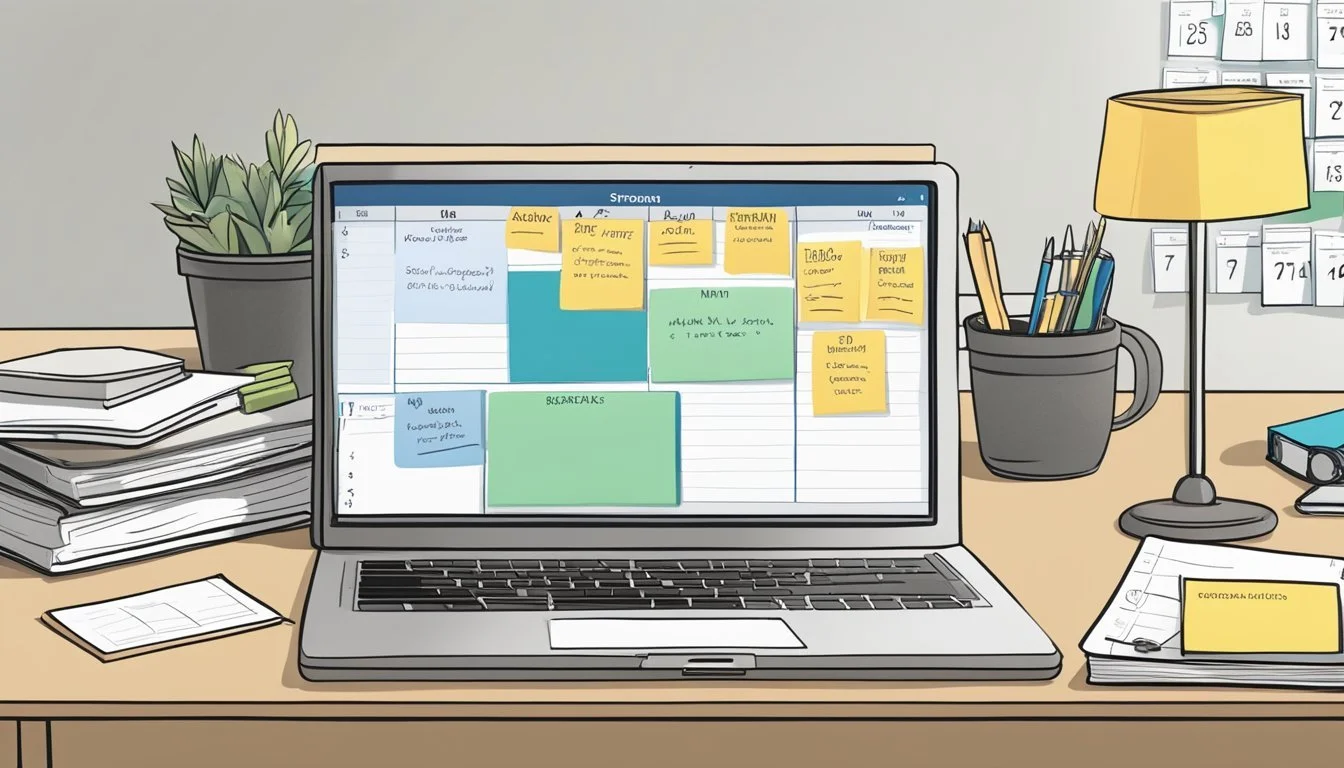7 Strategies for Overcoming Trauma-Related Procrastination
Expert Tips for Productivity
Procrastination is often misunderstood as a simple lack of motivation or laziness. However, for many, it is deeply rooted in psychological trauma and serves as a coping mechanism to avoid distressing emotions. Trauma can erode self-esteem and create avoidance behaviors that hinder one's ability to complete tasks.
Understanding the relationship between trauma and procrastination can empower individuals to adopt strategies that address these underlying issues. By recognizing procrastination as a response to past negative experiences, individuals can take meaningful steps toward overcoming it. This article introduces seven strategies specifically designed to help individuals break free from trauma-related procrastination, offering practical tools and insights to improve productivity and mental well-being.
1) Mindfulness Meditation Sessions
Mindfulness meditation can help individuals address procrastination stemming from trauma. These sessions encourage a state of present-moment awareness, reducing anxiety and stress. By focusing on the here and now, individuals can break free from the paralysis often caused by trauma.
In mindfulness meditation sessions, practitioners are guided to observe their thoughts without judgment. This practice builds resilience and emotional stability. It helps individuals recognize procrastination triggers and respond to them calmly and efficiently.
Research indicates that consistent mindfulness practice can improve focus and cognitive function. Regular sessions enhance the ability to start tasks without being overwhelmed by negative emotions. This approach can counter procrastination's underlying impulses.
Strategies for integrating mindfulness into daily routines include setting aside specific times for meditation and using mindfulness apps to maintain consistency. Individuals might also benefit from mindful walking or deep breathing exercises.
Adopting mindfulness techniques aids in managing stress and maintaining balance in the nervous system. Trauma-informed mindfulness can be especially effective, incorporating grounding and self-regulation techniques tailored for trauma survivors.
By making mindfulness a regular part of one’s routine, individuals can build a more proactive and focused mindset, crucial for overcoming procrastination linked to trauma.
2) Regular Physical Exercise Routine
Incorporating a regular physical exercise routine can significantly reduce procrastination triggered by trauma. Exercise releases endorphins, which improve mood and reduce anxiety. This can make it easier to tackle tasks that may otherwise feel overwhelming.
Exercise also helps with focus and cognitive function. Activities like yoga and aerobic workouts can enhance concentration, making it easier to get started on tasks.
Scheduling workouts can create a sense of structure. This routine can help individuals stay organized, reducing the chaos that often leads to procrastination. Aim to start with manageable goals, such as walking for 20 minutes three times a week.
Regular exercise can improve sleep quality, decreasing fatigue that contributes to procrastination. Establishing a consistent sleep and exercise routine can further enhance these benefits.
To combat exercise procrastination, choose activities that are enjoyable. This can include dancing, biking, or team sports. Enjoyable activities increase the likelihood of staying consistent with the routine.
Building a support system around physical activities can also be helpful. Joining a fitness class or exercising with a friend can provide motivation and accountability. This shared commitment can make it easier to stick to the routine.
3) Time Management Tools like Trello
Time management tools can be pivotal in overcoming trauma-related procrastination. Trello, for instance, is a versatile project management tool that employs boards, lists, and cards to help organize tasks.
Trello aids in visualizing workflow, setting priorities, and tracking progress. Users can break projects into smaller, manageable tasks, making it easier to focus on one step at a time.
Integration capabilities with other applications enhance Trello's functionality. Users can sync Trello with Google Calendar or Slack, ensuring they stay on top of deadlines and communications.
Besides Trello, other tools like Asana and Wrike provide similar benefits. They help manage tasks for individuals and teams, offering various features to optimize productivity.
Using these tools can help users build consistent work habits. By creating and sticking to schedules, users reduce the chances of procrastination triggered by trauma.
4) Cognitive Behavioral Therapy Techniques
Cognitive Behavioral Therapy (CBT) is one of the most effective techniques for addressing trauma-related procrastination. CBT involves identifying and challenging negative thought patterns that contribute to procrastination.
One key technique in CBT is cognitive restructuring. This method helps individuals recognize and modify distorted thinking, such as all-or-nothing thinking or overgeneralization. This can reduce feelings of being overwhelmed, making tasks seem more manageable.
Exposure therapy can also be beneficial. This method involves gradually exposing individuals to tasks or situations they avoid due to anxiety. Over time, this can help decrease avoidance behaviors and improve the ability to engage in necessary activities.
Behavioral activation is another useful technique. It focuses on increasing engagement in positive activities, helping to counteract the depression or anxiety that may follow trauma. This can significantly improve motivation and productivity.
Using CBT worksheets, as suggested by resources on trauma-focused CBT, can offer structured ways to address procrastination. These worksheets often guide users through exercises that promote healthier thinking and behavior patterns.
Incorporating elements like mindfulness meditation, another CBT tool, can further enhance emotional regulation and reduce procrastination. It helps individuals stay present, reducing distractions that contribute to procrastination.
CBT provides a structured approach to address procrastination tied to trauma by transforming thought patterns and behaviors that hinder productivity.
5) Support Groups for Trauma Survivors
Support groups provide a safe space for trauma survivors to share their experiences and offer mutual support. These groups create an environment where individuals can connect with others who have faced similar challenges.
Participation in these groups can lead to emotional relief. Sharing experiences helps reduce anxiety, fear, and loneliness. Many find comfort in knowing they are not alone in their struggles.
Trauma survivors often gain valuable coping skills through group discussions. These skills can enhance their ability to manage daily stressors and triggers. Moreover, regular interaction with peers can foster a sense of community and belonging.
Online peer support groups are increasingly popular. They offer flexibility and accessibility for those who may have mobility issues or prefer virtual meetings. Platforms like CPTSD Foundation's peer support chat group provide a space for survivors to connect digitally.
In-person support groups also remain vital. Organizations like the Trauma Survivor's Network host peer support groups that help connect trauma survivors in a supportive setting. These sessions allow for face-to-face interaction, which can be highly beneficial for some individuals.
It's important for trauma survivors to explore different support group options. Finding the right fit can significantly impact their recovery journey by enhancing their coping mechanisms and emotional well-being.
6) Reading Self-Help Books
Reading self-help books can be a powerful tool in overcoming trauma-related procrastination. These books often provide practical strategies, exercises, and real-life examples to help individuals understand and tackle procrastination.
Books such as "Getting Past Your Past" by Francine Shapiro offer insights into how trauma affects daily life. Shapiro, the founder of EMDR therapy, explains techniques that empower readers to regain control.
"The Complex PTSD Workbook" by Dr. Arielle Schwartz combines education and activities designed to address the complex layers of trauma. This book helps break down the recovery process into manageable steps, providing clarity and actionable advice.
For those looking to address procrastination itself, "The End of Procrastination" by Petr Ludwig and Adela Schicker can be an excellent resource. It offers science-based tools and a focus on motivation to help readers take action and build a satisfying life.
Engaging with self-help books allows individuals to explore their challenges at their own pace. These resources can serve as a complement to therapy or as a starting point for those not yet ready to seek professional help. By incorporating evidence-based techniques, readers can build resilience and move toward healing.
7) Setting Achievable Goals
Setting achievable goals helps manage anxiety and reduces the inclination to procrastinate. Unrealistic goals can lead to feelings of failure. Therefore, it's important to set specific, measurable, attainable, relevant, and time-bound (SMART) goals.
Starting with smaller tasks can build confidence and momentum. For instance, rather than aiming to complete an entire project, individuals can focus on finishing a small portion of it.
Breaking tasks into manageable steps can make them seem less overwhelming. Creating a detailed plan with specific actions and timelines can offer structure and clarity.
Celebrating progress, even small achievements, fosters a sense of accomplishment. This positive reinforcement can motivate ongoing effort and continual progress.
Setting clear priorities also plays a crucial role. By identifying what is most important, individuals can allocate their time and energy more effectively, which can prevent procrastination.
Setting limits and avoiding multitasking can further enhance focus and productivity. Concentrating on one task at a time allows for better performance and reduces stress.
Using these strategies, individuals can tackle their tasks more effectively and mitigate the effects of trauma-related procrastination.
Understanding Trauma-Related Procrastination
Trauma-related procrastination is a complex behavior often rooted in an individual's past experiences. Examining its definition, symptoms, psychological impact, and common triggers can provide better insight.
Definition and Symptoms
Trauma-related procrastination occurs when individuals delay tasks to avoid distressing emotions linked to traumatic experiences. Symptoms often include avoidance of specific tasks, difficulty focusing, and heightened anxiety.
Procrastination may be a coping mechanism to distance oneself from tasks that trigger past trauma. This persistent avoidance can become a chronic issue, affecting both personal and professional aspects of life.
Recognizing these symptoms is crucial for addressing the underlying trauma that perpetuates this procrastination.
Psychological Impact
The psychological impact of trauma-related procrastination is multi-faceted. It can lead to feelings of guilt, shame, and inadequacy due to an inability to complete tasks. This often results in a vicious cycle where procrastination exacerbates these negative emotions, further hindering productivity.
Moreover, hypervigilance, a trauma symptom, can drain energy and impede focus. The constant state of alertness makes it challenging to engage in tasks that require concentration. Understanding these psychological impacts is essential for developing effective strategies to overcome procrastination.
Common Triggers
Common triggers for trauma-related procrastination include tasks that resemble past traumatic events or evoke similar emotions. For example, an individual who experienced severe criticism during childhood may procrastinate on tasks requiring feedback.
Other triggers can include high-stress environments, fear of failure, and overwhelming responsibilities. Recognizing these triggers allows individuals to develop coping strategies that address the root cause of their procrastination, rather than just the behavior itself. Understanding these triggers can significantly improve one's ability to manage and mitigate procrastination effectively.
Mindfulness Techniques for Procrastination
Understanding how mindfulness can aid in reducing procrastination involves practicing meditation and engaging in guided exercises that specifically target procrastination triggers. These strategies help create awareness and foster a more compassionate approach to self-improvement.
Meditation Practices
Meditation is a powerful tool to combat procrastination. It encourages individuals to stay present and focused, reducing anxiety related to past or future tasks. One effective practice is mindfulness meditation, where individuals sit quietly and focus on their breath, bringing attention back whenever the mind wanders.
Another useful technique is body scan meditation, which involves paying attention to different parts of the body systematically. This practice helps in grounding and can bring awareness to physical sensations linked to stress or procrastination.
Incorporating these techniques into a daily routine can improve self-discipline and reduce the inclination to delay tasks.
Beneficial Guided Exercises
Guided exercises can provide additional structure to mindfulness practices. Loving-kindness meditation (metta) focuses on developing compassion for oneself and others, countering the negative self-talk that often accompanies procrastination.
Visualization exercises can also be beneficial. By visualizing the completion of a task, a person can reduce the mental barriers that contribute to procrastination. This creates a positive mental association with task completion, aiding in motivation.
Another guided exercise involves setting intentions at the start of each day. This practice helps in clearly defining goals and fostering a proactive mindset. Engaging in these guided exercises regularly can promote a more positive and productive approach to tackling tasks.
For more detailed practices on using mindfulness to address procrastination, exploring resources such as this Mindfulness Guide can be immensely helpful.
Cognitive Behavioral Strategies
Cognitive Behavioral Therapy (CBT) offers practical techniques to help individuals address procrastination rooted in trauma. By focusing on challenging negative thoughts and developing positive habits, these strategies can pave the way for meaningful progress.
Challenging Negative Thoughts
Cognitive restructuring is a core technique in CBT that helps individuals identify and challenge irrational or maladaptive thoughts. This method involves recognizing cognitive distortions, such as all-or-nothing thinking or catastrophizing, and reframing these thoughts into more balanced perspectives.
For example, someone might think, "If I can't do this perfectly, there's no point in trying at all." CBT encourages rephrasing this to, "Doing my best is better than not trying at all."
Self-compassion is also crucial. Treating oneself with kindness and understanding, especially during setbacks, helps reduce the fear and anxiety that magnify procrastination. Avoiding harsh self-criticism can prevent a downward spiral of negative thoughts.
In exposure therapy, another CBT technique, individuals gradually face the tasks they tend to avoid. By repeatedly confronting these tasks in a controlled manner, it becomes easier to manage associated anxiety. This technique is especially effective for those whose procrastination is intertwined with anxiety.
Developing Positive Habits
Building a structured routine can significantly reduce procrastination. Setting specific, achievable goals and breaking larger tasks into smaller, manageable steps can make the overall process less daunting. For individuals dealing with trauma, predictable routines create a sense of control and stability.
Incorporating reward systems can also motivate progress. For instance, after completing a challenging task, rewarding oneself with a favorite activity or treat reinforces positive behavior.
Practicing mindfulness and relaxation techniques can also aid in developing positive habits. Mindfulness helps individuals stay present and focused, reducing the urge to procrastinate. It serves as a grounding tool that mitigates the overwhelming feelings often associated with trauma.
Additionally, engaging in self-care activities like regular exercise, healthy eating, and adequate sleep supports mental well-being, fostering an environment where effective habits can thrive. These self-care practices contribute to a balanced mind, making it easier to follow through on commitments.
By integrating these cognitive behavioral strategies, individuals can build resilience and overcome procrastination linked to traumatic experiences.





